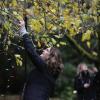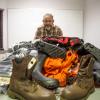December 18, 2007 - 1:52am
A team of Malaspina University-College researchers are spearheading a high profile, multi-year study to examine groundwater on Vancouver Island.
“Population growth, rapid development, and industrial and commercial land-use practices threaten the quality of our drinking water,” said Regan Purdy, senior research assistant. “This study will support decision-makers in future land-use planning, and in developing groundwater protection guidelines and policies.”
Called the Vancouver Island Water Resource Vulnerability Mapping Project, the study will analyze the susceptibility of water quality to hazards associated with human activities and land use.
It’s a collaborative project involving professors and students from Malaspina’s Chemistry, Geology and Geography departments, plus expertise and funding from the Ministry of Environment, Ministry of Health, Vancouver Island Health Authority, Natural Resources Canada, Islands Trust and Vancouver Island regional districts. Headed up by Malaspina professor and Geographic Information Systems (GIS) expert Dr. Alan Gilchrist, the team will generate a GIS map outlining groundwater vulnerability.
Malaspina Chemistry professor Dr. Erik Krogh explained that over 20,000 private wells supply drinking water to homeowners and municipalities on Vancouver Island and the Gulf Islands. "Well water comes from many types of aquifers on Vancouver Island, which have different characteristics that make them vulnerable to contamination from human activities on the surface," he said.
“Once contaminated, aquifers are extremely difficult to remediate and alternate sources are often at great expense to the users. Our research will provide a geographically-based predictive tool to prevent groundwater contamination by helping us to better understand the connectivity between activities on the surface and the underlying hydrology.”
Over the next four to six years, the study will focus on groundwater in the regional districts of Cowichan Valley and Nanaimo. The research team will acquire, compile and assess geological and hydro-geological data from a variety of public and private sources, and test and adapt mapping methodologies that are specific to Vancouver Island water resources.
Eventually, intrinsic susceptibility maps will be produced for the entire Vancouver Island region using a GIS-based methodology called DRASTIC. The maps will categorize aquifers on Vancouver Island that are deemed vulnerable.
“We’ll have low, medium and high ratings on the map, which tell the user that a particular area is high risk for future development due to intrinsic factors associated with the underlying geology, hydrology and potential contaminants,” added Purdy.
The maps and databases will provide a useful screening tool for city planners and other government decision-makers, aiding them in source protection initiatives, and providing a guide to areas that perhaps should be avoided for future development.
“We’ll also identify and compile an inventory of potential hazards and sources of contamination to water resources for the region, including old gas stations and landfill sites,” said Purdy. “We’ll include any site where human activity is detrimental, or has been detrimental, to ground water supplies.”
Purdy said in times of high precipitation and/or flooding, surface water can pick up hazardous and toxic materials, including animal waste, solvents, pesticides and fertilizers.
“This could pollute surface water bodies, and also seep into the ground, reaching some of our aquifers,” she said. “This can be dangerous to groundwater supplies. If flood water enters a well, for example, it can contaminate groundwater, making it unsafe to drink.”
Malaspina faculty involved in the multi-year study include Krogh (Chemistry), Gilchrist (Geography), and Dr. Steve Earle (Geology). Purdy graduated from Malaspina’s Natural Resource Management program in June 2006.
Tags: In the Community






